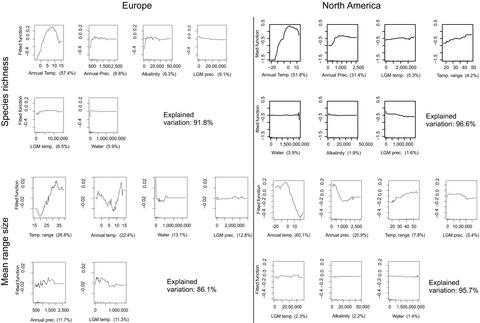Our official English website, www.x-mol.net, welcomes your feedback! (Note: you will need to create a separate account there.)
Current climate overrides historical effects on species richness and range size of freshwater plants in Europe and North America
Journal of Ecology ( IF 5.5 ) Pub Date : 2020-01-18 , DOI: 10.1111/1365-2745.13356 Janne Alahuhta 1 , Harri Antikainen 1 , Jan Hjort 1 , Aveliina Helm 2 , Jani Heino 3
中文翻译:

当前的气候超越了对欧洲和北美淡水植物物种丰富度和范围大小的历史影响
更新日期:2020-01-18
Journal of Ecology ( IF 5.5 ) Pub Date : 2020-01-18 , DOI: 10.1111/1365-2745.13356 Janne Alahuhta 1 , Harri Antikainen 1 , Jan Hjort 1 , Aveliina Helm 2 , Jani Heino 3
Affiliation

|
- The latitudinal diversity gradient hypothesis suggests that species richness should be highest at low latitudes, whereas Rapoport's rule states that largest ranges ought to be found for species at high latitudes. However, there is no consensus over these patterns and their underlying drivers in the freshwater realm.
- We investigated species richness and mean range size of freshwater plants in 50 × 50 km grid cells across Europe (40°N–71°N) and North America (25°N–78°N), supplemented with data based on 1° latitudinal bands for mean range size. We were especially interested to find out whether there are similarities and differences in these ecogeographical patterns and their underlying drivers between the continents due to their contrasting historical characteristics, spatial extent and topography.
- First, we used partial regression to reveal whether species richness and mean range size of freshwater plants have a linear or quadratic relationship with latitude. Second, we employed variation partitioning based on partial regression to model relationships between plant species richness and mean range size and four explanatory variable groups (i.e. environmental features, current climate, historical climate and geographical location). Third, we utilized boosted regression tree analysis to further investigate species richness and mean range size of freshwater plants in relation to a set of explanatory variables.
- Our results revealed that species richness showed relatively similar patterns in relation to latitude between the continents. Similarly, mean range size trends were alike in North America whether we used 50 × 50 km grid cell data or 1° latitudinal bands. Instead, different patterns in mean range size emerged between the used datasets in Europe. For both species richness and mean range size, current climate (with different individual predictor variables) was the main driver in both the continents, but historical effects had a small influence on the response variables.
- Synthesis . Our findings indicated that major ecogeographical rules can strongly vary for the same taxonomic group across broad scales between continents. It is also premature to rely solely on well‐known terrestrial taxonomic groups when drawing generalizations about ecogeographical rules.
中文翻译:

当前的气候超越了对欧洲和北美淡水植物物种丰富度和范围大小的历史影响
- 横向多样性梯度假说表明,在低纬度地区物种丰富度应最高,而拉坡波特法则指出,在高纬度地区物种应找到最大范围。但是,对于这些模式及其在淡水领域的潜在驱动力尚无共识。
- 我们调查了欧洲(40°N–71°N)和北美(25°N–78°N)的50×50 km网格中淡水植物的物种丰富度和平均范围,并补充了基于1°纬度的数据平均范围大小的条带。我们特别感兴趣的是,由于大陆的历史特征,空间范围和地貌的差异,这些生态地理模式及其潜在驱动因素之间是否存在异同。
- 首先,我们使用部分回归来揭示淡水植物的物种丰富度和平均范围大小与纬度是否具有线性或二次关系。其次,我们采用基于部分回归的变异分区来模拟植物物种丰富度与平均范围大小以及四个解释变量组(即环境特征,当前气候,历史气候和地理位置)之间的关系。第三,我们利用增强回归树分析进一步研究了与一组解释变量有关的物种丰富度和淡水植物的平均范围大小。
- 我们的结果表明,物种丰富度相对于各大陆之间的纬度显示出相对相似的模式。同样,无论我们使用的是50×50 km的网格单元数据还是1°的纬度带,北美的平均距离大小趋势都是相似的。相反,欧洲使用的数据集之间出现了不同的平均范围大小模式。对于物种丰富度和平均范围大小而言,当前气候(具有不同的单个预测变量)是这两个大陆的主要驱动力,但是历史影响对响应变量影响很小。
- 综合。我们的研究结果表明,同一大类之间的同一生态分类组的主要生态地理规则可能存在很大差异。在对生态地理规则进行概括时,仅依靠知名的陆地生物分类群还为时过早。


























 京公网安备 11010802027423号
京公网安备 11010802027423号